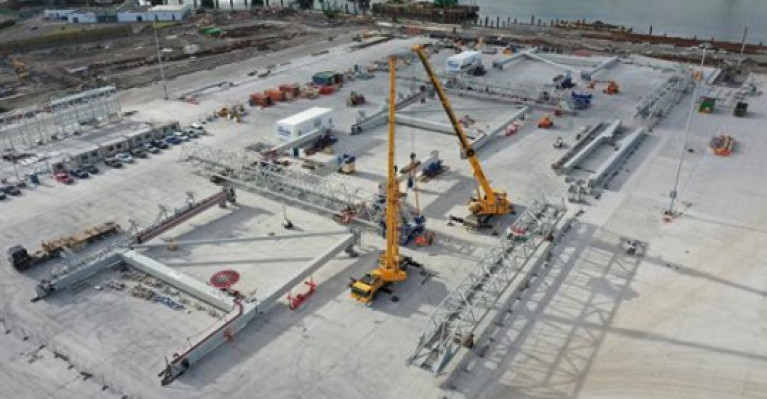Displaying items by tag: Assembly: STS Cranes
Assembling of Ship-to-Shore Cranes for Port of Cork's New Container Terminal
The assembling of ship-to-shore (STS) cranes has begun at the Port of Cork's new Container Terminal in Ringaskiddy.
The new Liebherr cranes according to the port company, will improve liners’ schedule reliability, and reduce trade costs and inventory holding outlays for shippers
In an announcement yesterday, the Port said it has taken delivery of two Liebherr post-panamax size (STS) container gantry cranes at the Cork Container Terminal. The assembly process has commenced on site and is due to be completed in the coming weeks.
The Port of Cork is the second largest port in the Republic of Ireland in terms of turnover. In 2019 the port handled total container traffic of 240,000 TEU. Thanks in part to the new Liebherr STS cranes, this is expected to increase by more than37% to approximately 330,000 TEU over the next decade in Cork Container Terminal.
Henry Kingston, Port Engineering Manager of the Port of Cork, said: “Liebherr Container Cranes in Killarney have been working with the Port of Cork for more than 50 years, and their port cranes, ship-to-shore container cranes, and rubber tyre gantry cranes (RTG) have been integral to making us the most seamless trade gateway in Ireland. Our first-hand experience of the top quality of Liebherr products and the first class after sales service back-u were key factors in influencing the decision to choose Liebherr for this project. In 2012, the Port of Cork and Liebherr collaborated in pioneering the very first fully electrically powered E-RTG crane in Ireland which has proven to be super reliable, as well as environmentally best in class.”
CCT will soon become a major enabler of growth for Cork city and Munster as well as the national economy. The funding for this development has come from Allied Irish Banks plc (AIB), the European Investment Bank (EIB), and the Ireland Strategic Investment Fund (ISFI), European Connecting Europe Facility Funds as well as self-finance, and these STS cranes will be core contributors to CCT’s growth in the 2020s and beyond.
The cranes were built less than 100 kilometres from Cork in Killarney, County Kerry, and are being assembled by local crane erection specialists William O’Brien Group., under the supervision of expert Liebherr engineers. Liebherr Container Cranes Ltd. is part of the Liebherr group and supplies container handling equipment to ports and rail terminals worldwide.
David Griffin Managing Director – Sales, Liebherr Container Cranes, said, “Port of Cork has a well-established reputation for fast ship turnarounds and facilitating efficient supply chains, so Liebherr was very satisfied to be the preferred choice to meet the Port’s high standards. These new cranes are fitted with the latest energy saving Liebherr Liduro drives, power management systems and safety features available in today’s STS crane markets. The cranes will have an outreach of 45m, a back reach of 15m and a lift height over rail of 32m, ensuring that they will have the lift and reach capacity to cater for the largest container vessels which will visit Cork in the coming decades.”
“Liebherr Container Cranes are industry leaders in terms of their high reliability, low downtimes and low maintenance and running costs, and will serve Cork Container Terminal well into the future.”
The contract was awarded to Liebherr in 2018 after a public tender process, and the opening of CCT later this year will deliver the fastest, most reliable, and cost-efficient container service available to local businesses as well as Ireland’s international exporters.
Construction on CCT began in June 2019 and will finish in 2020. The €80m project will initially offer a 360-metre-long quay with a 13-metre depth alongside. The development also includes the construction of a 13.5-hectare terminal and associated buildings.
























































